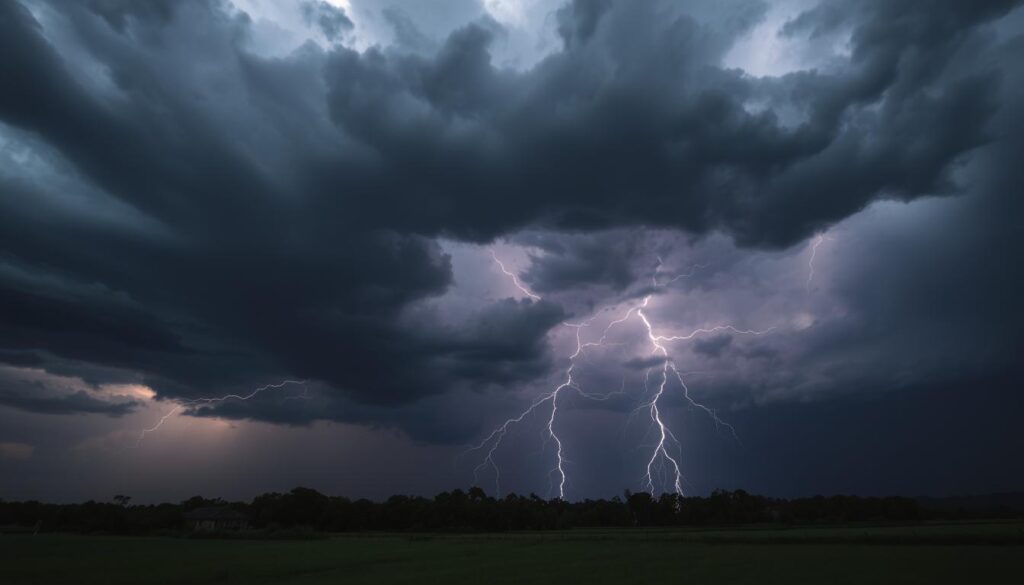As the sun set, the air became heavy with anticipation. People in a coastal town gathered around their radios, their eyes glued to the weather forecast. The weatherman’s words were dire: “A powerful hurricane is heading straight for us.” This was the moment they had feared – a hurricane watch had been declared, and the race to protect their homes and families had started.
When a tropical cyclone is on its way, preparation is crucial. Knowing the difference between hurricane watches, warnings, and can be a matter of life and death. By staying informed and taking action, families can better survive the storm.
Key Takeaways
- A hurricane watch means hurricane conditions are possible within 48 hours in the specified area.
- Residents should watch weather reports closely and be prepared to act if a hurricane warning is issued.
- Preparing an emergency kit, securing your property, and having a family evacuation plan are key to protecting against hurricane impacts.
- Following local authorities’ instructions and staying alert during a hurricane watch is vital for your family’s safety.
- Getting updates from reliable sources like the National Hurricane Center and local media is crucial for making informed decisions during severe weather.
The coastal community was on high alert as the storm approached. But with a solid emergency plan and a commitment to staying informed, they felt empowered to face the hurricane. They were determined to come out stronger on the other side.
Understanding Severe Thunderstorms
As the weather becomes more unpredictable, it’s vital to grasp the nature of severe thunderstorms and their potential dangers. The National Weather Service labels these storms as those that produce hail over 1 inch, wind gusts exceeding 58 mph, or a tornado. These intense weather systems can unleash a variety of threats, including damaging winds, large hail, and the risk of tornadoes.
What Constitutes a Severe Thunderstorm
A thunderstorm is deemed severe if it fulfills one or more of the following conditions:
- Hail size of 1 inch in diameter or larger
- Wind gusts of 58 mph or higher
- Tornado formation
Severe Weather Safety Checklist
Preparing for severe thunderstorms is essential to safeguard your family. Here’s a checklist to assist you in preparation:
- Check your emergency supplies and replenish any items that are missing or expired.
- Review your family’s severe weather plan and ensure everyone knows their role in case of a storm.
- Stay informed by monitoring weather alerts and storm monitoring services.
- Ensure your weather radios are functioning and easily accessible.
- Identify the safest room in your home to seek shelter in during a severe thunderstorm.
By understanding severe thunderstorms and taking proactive steps to prepare, you can safeguard your loved ones and property when the next storm hits.
Preparing for Severe Weather
Severe weather can hit without warning, making it vital to prepare ahead. To keep your family safe during storms, stay updated with weather information from reliable sources. Also, craft a detailed safety plan that fits your household’s unique needs.
Monitoring Weather Information
Keeping up with the latest weather forecasts and warnings is key. Sign up for weather alerts from trusted sources like the National Weather Service. This way, you’ll get updates quickly. Learn about different weather sources too, such as mobile apps, local news, and the NOAA website.
Creating a Safety Plan
Creating a solid emergency plan is crucial for your family’s safety. Identify the safest spots in your home, like an interior room or basement. Make sure everyone knows where to go. Also, have a family communication plan ready for emergencies. Stock up on disaster supplies to last your family a few days.
By taking these steps, you can better prepare your home for severe weather. This will help keep your loved ones safe during such events.

When a Watch Is Issued
When severe weather conditions like severe thunderstorm watches, tornado watches, or thunderstorm watches are predicted in your area, it’s crucial to stay informed and prepared. A weather watch indicates that the conditions are favorable for the development of severe weather. However, the exact timing and location of the event are still uncertain.
Staying Informed
During a weather watch, continuously monitor weather information from local news, weather websites, or mobile apps. This will help you stay up-to-date on the latest developments and any changes in the forecast. Be ready to take immediate action if a severe weather warning is subsequently issued for your location.
Activating Weather Radios
Another important step is to ensure your weather radio is powered on and set to your local frequency. These radios continuously broadcast National Weather Service updates. They can provide early alerts for impending severe weather, including thunderstorm watches, tornado watches, and severe weather watches. Activating your weather radio will help you stay informed and prepared, even if you’re unable to continuously monitor other news sources.
| Weather Radio Features | Benefits |
|---|---|
| Automatic alert activation | Receive immediate notifications of severe weather watches and warnings |
| Continuous monitoring | Stay informed about evolving weather conditions without actively checking multiple sources |
| Battery backup | Remain informed even during power outages |

By staying informed and activating your weather radio, you can ensure you’re prepared to respond quickly if a severe thunderstorm watch, tornado watch, or other severe weather watch is issued for your area.
Responding to Severe Thunderstorm Warnings
Upon receiving a severe thunderstorm warning, it’s imperative to act swiftly to safeguard yourself and your family. These storms can unleash powerful winds, hail, and even tornadoes. Being alert and taking the right steps can significantly reduce risks and ensure your safety.
Seeking Shelter
At the first sign of a severe thunderstorm, seek shelter in a sturdy building. Opt for one with a basement or an interior room on the lowest floor. Avoid windows, doors, and outer walls, as they are more susceptible to damage from high winds and debris. If outside, find a low-lying area away from trees, power lines, and other hazards. Crouch down to reduce your exposure.
Continuous Monitoring
It’s crucial to stay informed and monitor the situation closely during a severe thunderstorm. Keep an eye on weather updates from trusted sources like the National Weather Service or local news. Be aware of any shifts in the storm’s intensity or the risk of tornadoes. By staying vigilant and adjusting your response, you can better protect yourself and your loved ones.
Remember, severe thunderstorm warnings should never be ignored. These storms can escalate quickly, posing a significant threat to your safety. By taking the right actions and staying alert, you can increase your chances of safely weathering the storm.

“When a severe thunderstorm warning is issued, it’s critical to take immediate action to ensure your safety. Don’t hesitate to seek shelter and continuously monitor the situation for any changes or potential tornado risks.”
Tornado Warnings: Taking Immediate Action
Upon receiving a tornado warning, swift action is essential. Tornado safety is paramount, given the storms’ rapid development and intensity. Immediate response is critical to safeguard yourself and your family.
At the first warning, seek shelter without delay. Aim for the lowest floor of a solid building, ideally a basement or an interior room without windows. Stay away from windows, doors, and outside walls, as they are most exposed to debris.
- Protect yourself by covering your head with a helmet, such as a bike helmet, and wearing long-sleeved shirts and pants to shield against potential injuries from debris.
- If you are caught outdoors without access to a sturdy shelter, lie flat in a low-lying area, such as a ditch or ravine, and cover your head with your hands.
- Never attempt to outrun a tornado in your vehicle. Seek shelter immediately, and avoid seeking refuge under highway overpasses, as they can actually increase the wind speeds and create a more dangerous situation.
Once in a safe location, remain there until the warning is lifted. Continuous monitoring of the situation and any updated weather information is crucial, as tornado conditions can change rapidly. Be prepared to take further protective actions if necessary.
| Tornado Safety Checklist | Protective Actions |
|---|---|
|
|
Responding to tornado warnings with swift, decisive action can mean the difference between safety and disaster. By understanding the immediate steps to take and prioritizing your personal protection, you can increase your chances of weathering the storm safely.
“The best defense against a tornado is to be prepared and take shelter immediately when a warning is issued.”
Knowing the Current Forecast
Staying informed about the latest weather forecasts is crucial for preparing and responding to severe weather events. The National Weather Service (NWS), a division of the National Oceanic and Atmospheric Administration (NOAA), plays a vital role in keeping the public up-to-date with valuable weather information services.
How the National Weather Service Keeps You Informed
The National Weather Service provides a comprehensive range of weather forecasts, alerts, and warnings to help individuals and communities stay safe. From daily weather outlooks to severe thunderstorm and tornado warnings, the NWS utilizes various communication channels to ensure the public is well-informed about the current and impending weather conditions.
- Weather Forecasts: The NWS offers detailed weather forecasts, including temperature, precipitation, and wind predictions, to help people plan their daily activities and prepare for potential severe weather.
- Weather Watches and Warnings: When conditions indicate the possibility of severe weather, such as thunderstorms or tornadoes, the NWS issues weather watches and warnings to alert the public and prompt them to take appropriate safety measures.
- Storm Tracking: The NWS utilizes advanced radar technology and satellite data to monitor the development and movement of storms, providing real-time updates on the severity and trajectory of weather systems.
- Multiple Communication Channels: To reach the widest audience, the NWS disseminates weather information through various channels, including NOAA weather radios, mobile apps, social media, and local media outlets, ensuring that weather alerts and warnings are readily accessible.
By staying tuned to the National Weather Service’s comprehensive weather information services, individuals can make informed decisions and take proactive steps to protect themselves and their loved ones from the potential dangers of severe weather events.
Hurricane Watch: Key Considerations
When a hurricane watch is issued, immediate action is necessary to safeguard lives and property. Hurricane watches signal a possible tropical cyclone threat within the next 48 hours. Coastal residents must prepare for evacuation if ordered to do so.
Monitoring the storm’s progression is vital. Keep abreast of the hurricane’s projected path, intensity, and potential impacts. This includes storm surge risks and severe wind gusts. Always follow evacuation orders from local authorities, as they possess the latest information.
Ensure you have an emergency kit with vital supplies. This includes water, non-perishable food, flashlights, batteries, and a first-aid kit. Secure your property by bringing in outdoor furniture, trimming trees, and reinforcing windows and doors. This minimizes hurricane preparedness risks.
- Stay alert for hurricane watches and tropical cyclone threats.
- Closely monitor the storm’s progress and potential impacts, including storm surge risks and coastal evacuation needs.
- Assemble an emergency kit with essential emergency supplies.
- Secure your property by protecting windows, doors, and outdoor items to reduce property protection concerns.
Hurricane preparedness is key to keeping you and your family safe. By taking proactive steps and following all warnings, you can significantly reduce the risks posed by these powerful storms.
“The best defense against a hurricane is to be prepared well in advance.”
Severe Weather Resources
Staying informed and prepared is key when facing severe weather. Luckily, many resources and tools are available to help you become “weather-ready.” From mobile apps that offer real-time updates to community-based programs, these tools empower you to protect your family and home.
Being Weather-Ready
Downloading weather-related mobile apps is a great way to stay informed. These apps give you instant access to forecasts, warnings, and radar imagery. This allows you to track changes easily. Many municipalities and local organizations also offer programs. These programs teach residents how to prepare for and respond to severe weather.
Notification Systems
Having reliable emergency alert systems is crucial. They ensure you get timely warnings about severe weather. Services like the Integrated Public Alert and Warning System (IPAWS) and local emergency management agencies send critical information to your devices. This enables you to act quickly and protect your family.
FAQ
What defines a severe thunderstorm?
A severe thunderstorm is characterized by hail one inch or larger, wind gusts over 58 mph, or a tornado. These criteria signify the storm’s intensity and potential danger.
What should I do to prepare for a severe thunderstorm?
To prepare for severe thunderstorms, check your emergency supplies and review your safety plans. Stay updated with weather forecasts and secure outdoor items that could become projectiles. This proactive approach ensures your safety during severe weather.
How can I stay informed about severe weather in my area?
Staying informed about severe weather is crucial. Regularly check weather forecasts and hazardous weather outlooks. Set up weather alert notifications and have multiple ways to receive warnings, such as NOAA weather radios and mobile apps.
What’s the difference between a weather watch and a weather warning?
A weather watch indicates conditions are favorable for severe weather to develop. Conversely, a weather warning signifies severe weather is imminent or occurring. When a watch is issued, continue monitoring the situation and be prepared to take action if a warning is issued.
What should I do when a severe thunderstorm warning is issued?
Upon receiving a severe thunderstorm warning, seek shelter in a sturdy building. Avoid windows and continuously monitor the situation for any changes or the potential development of a tornado.
How do I respond when a tornado warning is issued?
When a tornado warning is issued, act quickly. Seek the most secure shelter available, such as a basement or interior room. Protect yourself from flying debris and avoid dangerous situations like seeking refuge under highway overpasses.
How does the National Weather Service provide weather information to the public?
The National Weather Service disseminates weather outlooks, watches, and warnings through various channels. These include NOAA weather radios, mobile apps, and local media outlets. It’s essential to have multiple ways to receive these alerts to stay informed about evolving weather conditions.
What should I do when a hurricane watch is issued?
When a hurricane watch is issued, closely monitor the storm’s progress. Prepare emergency supplies, secure your property, and be ready to evacuate if necessary. Heeding hurricane warnings and taking appropriate protective measures is crucial to safeguard lives and minimize property damage.
